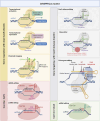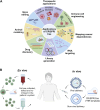Revolutionizing in vivo therapy with CRISPR/Cas genome editing: breakthroughs, opportunities and challenges
- PMID: 38362491
- PMCID: PMC10867117
- DOI: 10.3389/fgeed.2024.1342193
Revolutionizing in vivo therapy with CRISPR/Cas genome editing: breakthroughs, opportunities and challenges
Abstract
Genome editing using the CRISPR/Cas system has revolutionized the field of genetic engineering, offering unprecedented opportunities for therapeutic applications in vivo. Despite the numerous ongoing clinical trials focusing on ex vivo genome editing, recent studies emphasize the therapeutic promise of in vivo gene editing using CRISPR/Cas technology. However, it is worth noting that the complete attainment of the inherent capabilities of in vivo therapy in humans is yet to be accomplished. Before the full realization of in vivo therapeutic potential, it is crucial to achieve enhanced specificity in selectively targeting defective cells while minimizing harm to healthy cells. This review examines emerging studies, focusing on CRISPR/Cas-based pre-clinical and clinical trials for innovative therapeutic approaches for a wide range of diseases. Furthermore, we emphasize targeting cancer-specific sequences target in genes associated with tumors, shedding light on the diverse strategies employed in cancer treatment. We highlight the various challenges associated with in vivo CRISPR/Cas-based cancer therapy and explore their prospective clinical translatability and the strategies employed to overcome these obstacles.
Keywords: CRISPR/Cas; cancer; genome editing; in vivo trials; personalized therapies; precision medicine.
Copyright © 2024 Macarrón Palacios, Korus, Wilkens, Heshmatpour and Patnaik.
Conflict of interest statement
All authors are employed by GenCC GmbH & Co. KG. The authors declare that the research was conducted in the absence of any other commercial or financial relationships that could be construed as a potential conflict of interest.
Figures




References
Publication types
LinkOut - more resources
Full Text Sources

